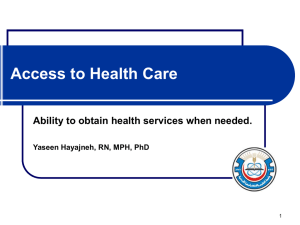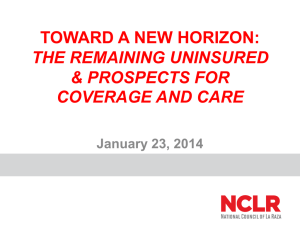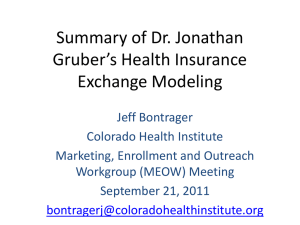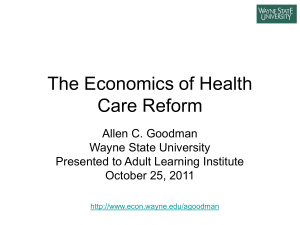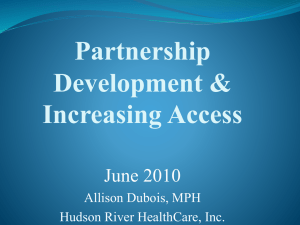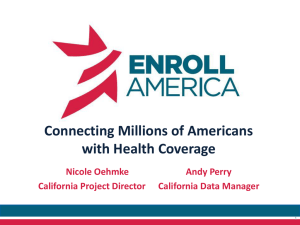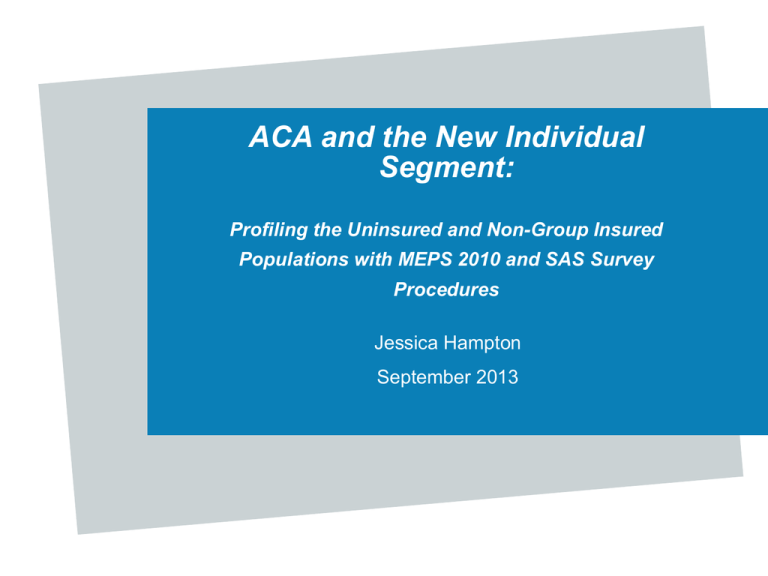
ACA and the New Individual
Segment:
Profiling the Uninsured and Non-Group Insured
Populations with MEPS 2010 and SAS Survey
Procedures
Jessica Hampton
September 2013
Presentation Outline
•
•
•
•
•
Introduction
• Statement of Purpose
• PPACA
• MEPS 2010
• Survey Design
• Literature Review
• Intro to SAS Survey Procedures
Data Preparation
• Selected Variables
• Derived Variables
Statistical Analysis
• PROC SURVEYMEANS
• PROC SURVEYFREQ
• Profiles (with PROC CORR, PROC SURVEYREG)
• CART Models (SPSS)
• PROC SURVEYLOGISTIC Models
Conclusions/Recommendations
References
2
Introduction
Statement of Purpose
•
•
•
Use MEPS 2010 data (most recent available)
With SAS survey procedures to:
• Identify drivers of total and out of pocket medical expenditures for adults 1865
• Discover significant predictors of uninsured and private non-group insured
segments
• Profile these populations of interest
• Compare mean expenditures across populations with regard to insurance
coverage status
• Estimate the size of these segments as of 2010
Why?
• Prior to ACA, underwriting practices denied coverage to high risk (high cost)
individuals
• Individual market is changing
• Although underwriters no longer allowed to deny coverage, customer
profiles are used to identify desirable characteristics (low risk/low cost) in
order to target those individuals in direct marketing campaigns.
• Profiles also useful in retention and engagement strategies
4
PPACA/ACA
•
•
•
•
•
•
•
•
•
•
•
•
•
•
•
Patient Protection and Affordable Care Act (March 2010)
Full implementation January 1, 2014
Guaranteed coverage for people with pre-existing conditions
Minimum standards for coverage
Phases out annual and lifetime maximums
Standardized premiums with regard to gender and prior medical diagnoses
Pricing based on age and smoking status
Smoothes age-based premium differences (younger people will pay more than
they used to)
Income-based subsidies (up to 400% poverty level)
Health insurance exchanges for each state to facilitate purchase
Penalizes those who elect not to purchase health insurance
Health insurance sales tax
Dramatically expands the individual segment
Previously uninsured purchase insurance through the exchanges
Others lose their private employer group coverage
5
Medical Expenditures Panel Survey (MEPS)
•
•
•
•
•
•
•
•
•
Administered annually by the U.S. Department of Health and Human Services
since 1996
Agency for Healthcare Research and Quality (AHRQ)
Anonymity protected by removing individual identifiers from the public data files
MEPS 2010 consolidated data file released September 2012
Multiple components (household, insurance/employer, and medical provider).
Household component (1,911 variables) covers the following topics:
• Demographics
• Household income
• Employment
• Diagnosed health conditions
• Additional health status issues
• Medical expenditures and utilization
• Satisfaction with and access to care
• Insurance coverage
18,692 after excluding out of scope, negative person weights, under 18 and 65+
U.S. civilian, noninstitutionalized population
~3% out of scope (birth/adoption, death, incarceration, living abroad)
6
MEPS Survey Design Methods
•
•
•
•
MEPS is a representative but NOT a random sample of the population
Person weights must be used to produce reliable population estimates
Stratification:
• By demographic variables such as age, race, sex, income, etc.
• Goal is to maximize homogeneity within and heterogeneity between strata
• Sometimes used to oversample certain groups under-represented in the
general population or with interesting characteristics relevant to study
• For example: blacks, Hispanics, and low-income households
Clustering:
• By geography in order to reduce survey costs -- not feasible or costeffective to do a random sample of the entire population of the U.S.
• Within-cluster correlation underestimates variance/error -- two families in
the same neighborhood are more likely to be similar demographically (for
example, similar income)
• Desire clusters spatially close for cost effectiveness but as heterogeneous
within as possible for reasonable variance.
• Multi-stage clustering used in MEPS:
• sample of counties >> sample of blocks >> individuals/households
surveyed from block sample
7
Survey Design Considerations
•
•
•
•
•
If person weights are ignored and one tries to generalize sample findings to the
entire population, total numbers, percentages, or means are inflated for the
groups that are oversampled and underestimated for others
In regression analysis, ignoring person weights leads to biased coefficient
estimates
If sampling strata and cluster variables are ignored, means and coefficient
estimates are unaffected, but standard error (or population variance) may be
underestimated; that is, the reliability of an estimate may be overestimated
Or when comparing one estimated population mean to another, the difference
may appear to be statistically significant when it is not
(Machlin, S., Yu, W., & Zodet, M., 2005)
8
Literature Review
Literature Review – KFF 2011
•
•
•
•
•
•
•
•
•
Most literature focuses on data available prior to 2012 which describes these
segments (uninsured/non-group) through 2008
Kaiser Family Foundation (KFF) 2011 study, “A Profile of Health Insurance
Exchange Enrollees,” based on MEPS 2007
Model simulation of demographic, health, and medical utilization profiles of the
people expected to enroll in exchanges by 2019
Compares exchange population profile to privately insured and uninsured
Estimates the exchange population in 2019 to include:
• 16 million formerly uninsured individuals
• 5 million formerly employer group insured
• 1 million formerly private non-group insured
Exchange population older, with lower education and income levels, more
racially diverse than current privately insured population
Expect self-reported worse health but fewer pre-existing medical diagnoses,
possibly due to lack of access to care
Expect utilization and expenditures to increase for the previously uninsured once
they gain access to care – similar to those of non-group insured
Some higher income will continue purchasing non-group insurance outside of
the exchanges – those with lower income will favor exchanges
10
Literature Review – KFF 2010
•
•
•
•
•
•
•
2010 study by KFF: “Comparison of Expenditures in Nongroup and Employer
Sponsored Insurance: 2004-2007
Recent focus on the non-group market prompted by healthcare reform, which
would expand the non-group market
DiJulio and Claxton, study authors, use combined data from MEPS 2004-2007
for the nonelderly adult population
Non-group insured have lower premiums, higher out-of-pocket expenses and
better (self-reported) health than the private employer group segment
Implies some combination of more cost-sharing, higher deductible levels, and/or
less coverage for non-group
If lower income people are entering the group market, they may not be able to
afford the high out-of-pocket costs
Plans may need higher premiums if the uninsured population is not as healthy
as the non-group segment (DiJulio, B. & Claxton, G., 2010)
11
Literature Review – KFF 2008
•
•
•
•
•
•
•
2008 Kaiser study, prior to ACA being signed into law: “How Non-Group Health
Coverage Varies with Income”
Based on combined data from MEPS 2000-2003 for nonelderly adults
Finds that even higher income people may prefer to remain uninsured than to
buy in the non-group market if they have no coverage offered through an
employer
At 4x the poverty level, 25% purchase non-group
At 10x the poverty level, only 50% purchase non-group coverage
Although people are more likely to purchase non-group plans at higher income
levels, study concludes that the non-group insurance market is unattractive to
consumers
Insurers either need to improve their product or the government needs to
subsidize such plans even for higher incomes in order to encourage participation
12
Literature Review – MEPS Statistical Brief 2009
•
•
•
•
•
A MEPS statistical brief from 2009 examines trends in group and non-group
private coverage
1996-2007, nonelderly adult population
65% had private group coverage at some time in 2007
Percentage private group has remained similar since 1996, with increasing
overall numbers corresponding to population increase
Non-group coverage has declined in the same time period, falling from 6% to
4% (Cohen, J.W. & Rhoades, J.A., 2009).
13
Literature Review – O’Neill & O’Neill 2009
•
•
•
•
•
•
O’Neill and O’Neill (2009) conducted an analysis of the characteristics of the
uninsured population
Employment Policies Institute study finds that a large portion of the uninsured
are “voluntarily uninsured”
• Percentage varies by state from as low as 27% to as high as 55%
• Defined as nonelderly adults at or exceeding 2.5 times the poverty level
The media tends to portray the uninsured population as being in very poor
health and without options, but the authors say this portrayal is exaggerated and
does not present a full picture
Uninsured population has very different demographic characteristics from the
privately insured:
• young
• low education levels
• immigrants
• lower medical utilization/expenditure levels
Higher mortality rates (about 3% higher than those of the privately insured
segment after controlling for other risk factors such as smoking) among
uninsured
Lack of health insurance coverage not the major contributing factor – other
disadvantages associated with poor health, such as lack of education (O’Neill &
O’Neill, 2009)
14
Literature Review – Summary
•
•
•
•
•
•
•
•
•
Private non-group coverage declining over time
Non-group market unpopular and overpriced
Non-group insured have lower premiums, higher out-of-pocket expenses and
better (self-reported) health than the private employer group segment
Large portion of the uninsured are “voluntarily uninsured”
Uninsured population has very different demographic characteristics from the
privately insured
Exchange population characteristics will be driven by large influx of formerly
uninsured
Lower education and income levels, more racial diversity than current privately
insured population
Fewer pre-existing medical diagnoses
Conflicting information on whether uninsured population is actually healthier or
not
15
SAS Survey Procedures
SAS Survey Procedures
•
•
•
•
•
•
•
•
Intended for use with sample designs that may include unequal person weights,
clustering, and stratification.
PROC SURVEYMEANS estimates population totals, percentages, and means.
Includes estimated variance, confidence intervals, and descriptive statistics.
PROC SURVEYFREQ produces frequency tables, population estimates,
percentages, and standard error.
PROC SURVEYREG estimates regression coefficients by generalized least
squares.
PROC SURVEYLOGISTIC fits logistic regression models for discrete response
(categorical) survey data by maximum likelihood.
PROC SURVEYMEANS and PROC SURVEYREG available starting with SAS
version 8.
PROC SURVEYFREQ and PROC SURVEYLOGISTIC available starting with
version 9.
PROC SURVEYSELECT for sampling which will not be used in this project
17
PROC SURVEYMEANS Syntax
PROC SURVEYMEANS DATA=PQI.MEPS_2010;
STRATA VARSTR;
CLUSTER VARPSU;
WEIGHT PERWT10F;
DOMAIN INSCOV10;
VAR TOTEXP10 TOTSLF10;
RUN;
18
PROC SURVEYMEANS Output
19
PROC SURVEYFREQ Syntax
PROC SURVEYFREQ DATA=PQI.MEPS_2010;
STRATA VARSTR;
CLUSTER VARPSU;
WEIGHT PERWT10F;
TABLES PRIEU10 PRING10 INSCOV10;
RUN;
20
PROC SURVEYFREQ Output
21
PROC SURVEYREG Syntax
PROC SURVEYREG DATA=PQI.MEPS_2010;
STRATA VARSTR;
CLUSTER VARPSU;
WEIGHT PERWT10F;
MODEL &TARGET=&&VAR&I /SOLUTION;
ODS OUTPUT
PARAMETERESTIMATES=PARAMETER_EST
FITSTATISTICS=FIT;
RUN;
22
PROC SURVEYLOGISTIC Syntax
PROC SURVEYLOGISTIC
DATA=SASUSER.MEPS_2010;
STRATA VARSTR;
CLUSTER VARPSU;
WEIGHT PERWT10F;
MODEL TOTEXP_HIGH(EVENT='1')=AGE10X
MARRIED--HISPANX POVLEV10--PHYACT53
OBESE--ADSMOK42 ADINSA42--LOCATN_ER;
ODS OUTPUT
PARAMETERESTIMATES=WORK.PARAM;
RUN;
23
PROC SURVEYLOGISTIC/REG Output
Default output (similar to PROC LOGISTIC and PROC REG):
•
•
•
•
•
•
•
fit statistics (AIC, Schwartz’s criterion, R-square)
chi-squared tests of the global null hypothesis
degrees of freedom
coefficient estimates
standard error of coefficient estimates and p-values
odds ratio point estimates
95% Wald confidence intervals
Does not include:
•
•
Option for stepwise selection
chi-squared test of residuals/tabled residuals (assumptions of normality and
equal variance do not apply)
• influential obs/outliers (person weights)
24
Data Preparation
Selected Variables - Demographic
Variable Name
SAS Label
Comments
Pseudo
Values?
AGE10X
AGE AS OF 12/31/10
(EDITED/IMPUTED)
Top-coded at 85+
N
MARRY10X
(MARRIED)
MARITAL STATUS12/31/10
(EDITED/IMPUTED)
Categorical. 1=married, 2=widowed,
3=divorced, 4=separated, 5=never married,
6=NA b/c under 16
Y
FTSTU10X
STUDENT STATUS IF
AGES 17-23 – 12/31/10
Categorical. 1=full time student, 2=part
time, 3=not student, skipped if not in age
range
Y
EDUCYR
YEARS OF EDUC WHEN
FIRST ENTERED MEP
Ordinal. Values 0-17, 17=5+ years college
Y
SEX (MALE)
SEX
Categorical. 1=male, 2=female
N
RACEX
RACE (EDITED/IMPUTED)
Categorical. Codes changed in 2002.
Values 1-6, 1=White, no other race,
2=Black, 3=Amer Indian/Alaskan native,
4=Asian, 5=Native Hawaiian/Pacific
Islander, 6=Multiple
N
HISPANX
HISPANIC ETHNICITY
(EDITED/IMPUTED)
Codes changed in 2002. 1=Hispanic,
2=not Hispanic
N
26
Selected Variables - Income
Variable Name
SAS Label
WAGEP10X
PERSON’S WAGE INCOME
TTLP10X
PERSON’S TOTAL
INCOME
FAMINC10
FAMILY’S TOTAL INCOME
POVCAT10
FAMILY INC AS % OF
POVERTY LINE –
CATEGORICAL
POVLEV10
FAMILY INC AS % OF
POVERTY LINE –
CONTINUOUS
Comments
Pseudo
Values?
N
Including interest, dividends, wages, child
support, alimony, pensions, etc.
N
N
1=poor/negative, 2=near poor, 3=low
income, 4=middle income, 5=high income
N
N
27
Selected Variables - Diagnoses
Variable Name
SAS Label
Comments
Pseudo Values?
HIBPDX
HIGH BLOOD PRESSURE DIAG
(>17)
If ends in DX, 1=ever diagnosed, 2 else
Y
BPMLDX
MULT DIAG HIGH BLOOD
PRESS (>17)
Skips if HIBPDX=2
Y
CHDDX
CORONARY HRT DISEASE
DIAG (>17)
If ends in DX, 1=ever diagnosed, 2 else
Y
ANGIDX
ANGINA DIAGNOSIS (>17)
If ends in DX, 1=ever diagnosed, 2 else
Y
MIDX
HEART ATTACK (MI) DIAG
(>17)
If ends in DX, 1=ever diagnosed, 2 else
Y
OHRTDX
OTHER HEART DISEASE DIAG
(>17)
If ends in DX, 1=ever diagnosed, 2 else
Y
STRKDX
STROKE DIAGNOSIS (>17)
If ends in DX, 1=ever diagnosed, 2 else
Y
EMPHDX
EMPHYSEMA DIAGNOSIS
(>17)
If ends in DX, 1=ever diagnosed, 2 else
Y
CHOLDX
HIGH CHOLESTEROL
DIAGNOSIS (>17)
If ends in DX, 1=ever diagnosed, 2 else
Y
CANCERDX
CANCER DIAGNOSIS (>17)
If ends in DX, 1=ever diagnosed, 2 else
Y
DIABDX
DIABETES DIAGNOSIS (>17)
If ends in DX, 1=ever diagnosed, 2 else
Y
ARTHDX
ARTHRITIS DIAGNOSIS (>17)
If ends in DX, 1=ever diagnosed, 2 else
Y
ARTHTYPE
(RADX)
TYPE OF ARTHRITIS
DIAGNOSED (>17)
1=RA, 2=OA, 3=not specified. Skipped if
ARTHDX=2
Y
ASTHDX
ASTHMA DIAGNOSIS
If ends in DX, 1=ever diagnosed, 2 else
Y
28
Selected Variables – Behavioral Risks/Preventive Care
Variable Name
SAS Label
Comments
Pseudo
Values?
DENTCK53
HOW OFTEN DENTAL
CHECK-UP – RD 5/3
Ordinal. 1=twice a year or more, 2=once a
year, 3=<once a year, 4=never
Y
CHECK53
HOW LNG LST ROUTNE
CHECKUP (>17)-RD 5/3
Ordinal. How long since last physical:
1=within past year, 2=past 2 yrs, 3=past 3
yrs, 4=past 5 yrs, 5=5+ yrs, 6=never
Y
PHYACT53
MOD/VIG PHYS ACTIV 3X
WK (>17) – RD 5/3
1=Meets recommended physical activity
guidelines, 2 otherwise
Y
BMINDX53
ADULT BODY MASS
INDEX (>17) – RD 5/3
>=25.0-29.9 is overweight and >=30 is
obese; <18.5 is underweight. Create flags,
categorical fields.
Y
ADSMOK42
SAQ: CURRENTLY
SMOKE
1=currently smoke, 2 otherwise.
Y
ADAPPT42
SAQ 12 MOS: # VISITS TO
MED OFF FOR CARE
Ordinal. # times went to dr. or clinic past
12 mnths: 1-4, 5=5-9x, 6=10+
Y
HAVEUS42
AC05 DOES PERSON
HAVE USC PROVIDERR4/2
USC = usual source of care; 1=yes, 2=no
Y
LOCATN42
USC LOCATION-R4/2
Categorical. 1=office, 2=hospital (not
ER), 3=ER. Skips if HAVEUS42=2
Y
29
Selected Variables – Expenditures/Utilization
Variable Name
SAS Label
Comments
Pseudo Values?
TOTEXP10
TOTAL HEALTH CARE EXP 10
N
TOTSLF10
TOTAL AMT PAID BY
SELF/FAMILY 10
N
ERTEXP10
TOTAL ER FACILITY + DR EXP
10
N
ERTOT10
# EMERGENCY ROOM VISITS
10
N
RXEXP10
TOTAL RX-EXP 10
N
OPTEXP10
TOTAL OUTPATIENT FAC + DR
EXP 10
N
OPTOTV10
# OUTPATIENT DEPT
PROVIDER VISITS 10
N
OBVEXP10
TOTAL OFFICE-BASED EXP 10
N
OBTOTV10
# OFFICE-BASED PROVIDER
VISITS 10
N
IPTEXP10
TOT HOSP IP FACILITY + DR
EXP 10
N
IPNGTD10
# NIGHTS IN HOSP FOR
DISCHARGES, 2010
N
30
Selected Variables – Insurance Coverage
Variable Name
SAS Label
Comments
Pseudo
Values?
INSCOV10
HEALTH INSURANCE
COVERAGE INDICATOR
10
Summarizes health insurance coverage for
2010: 1=any private insurance at any time
during 2010, 2=public only, 3=uninsured
all 2010. Consolidates info from the
following variables: PRIVAT10,
PUBAT10X, UNINS10.
N
UNINS10
UNINSURED ALL OF 10
1=uninsured all 2010, 2 otherwise
N
PRIVAT10
ANY TIME COV PRIVATE
INS - 12/31/10
1=any private insurance at any time during
2010, 2 otherwise
N
PUBAT10X
ANY TIME COV BY
PUBLIC - 12/31/10
1=public insurance only in 2010, 2
otherwise
N
PRING10
COV BY NON-GROUP INS
- 12/31/10
1=covered by non-group insurance, 2
otherwise
N
PRIEU10
COV BY EMPL/UNION
GRP INS – 12/31/10
1=covered by group insurance through
employer/union, 2 otherwise
N
ADINSA42
DO NOT NEED HEALTH
INSURANCE
Scale of 1 to 5; 1=disagree strongly,
2=disagree somewhat, 3=uncertain,
4=agree somewhat, 5=agree strongly
Y
ADINSB42
HEALTH INSURANCE
NOT WORTH COST
Scale of 1 to 5; 1=disagree strongly,
2=disagree somewhat, 3=uncertain,
4=agree somewhat, 5=agree strongly
Y
31
Selected Variables – Derived/Transformed
Derived/Filled Variable
Original Variable
Comments
OBESE
BMINDX10
1 = BMINDX10 >=30; 0 otherwise
OVERWGHT
BMINDX10
1 = BMINDX10 >=25 and <30; 0 otherwise
MARRIED
MARRY10X
Filled. 1= married; 0 unmarried
FTSTU10X
FTSTU10X
Filled. 1 = full time student; 0 otherwise
MALE
SEX
Filled. 1 = Male; 0 otherwise
ARTHTYPE (RADX)
ARTHTYPE
Filled. 1 = RA arthritis; 0 otherwise
NUMDX
DX fields
Derived count of diagnoses.
WHITE
RACEX
1 = white, no other race; 0 otherwise
BLACK
RACEX
1 = black; 0 otherwise
NATIVE_AMER
RACEX
1 = American Indian/Alaskan native; 0 otherwise
PAC_ISL
RACEX
1 = Pacific islander/Hawaiian native; 0 otherwise
ASIAN
RACEX
1 = Asian; 0 otherwise
LOCATN_OFFICE
LOCATN42
1 = doctor’s office location of usual source of care
LOCATN_HOSP
LOCATN42
1 = hospital (non-ER) usual source of care; 0 otherwise
LOCATN_ER
LOCATN42
1 = ER usual source of care; 0 otherwise
TOT_EXP_HIGH
TOTEXP10
1 = total expenditures above mean expenditures for population; 0
otherwise
ADINSA42
ADINSA42
“I’m healthy enough that I do not need health insurance”: 1 = agree
somewhat/agree strongly; 0 otherwise
ADINSB42
ADINSB42
Health insurance not worth cost: 1 = agree somewhat/agree strongly; 0
otherwise
32
Data Overview
Summarized Output from PROC SURVEYMEANS/FREQ
Population
•
•
•
•
•
•
•
N
Weighted N
% of
Total
Pop
Mean Total
Expenditures
Mean
Total
OOP
OOP as
% of
Total
Adults < 65
18692
191331757
100%
$3751.61
$585.01
16%
Any Private
11274
135484885
71%
$3953.05
$670.45
17%
Private Non-Group
397
5390985
3%
$3079.40
$992.83
32%
Private Empl Group
9410
113367234
59%
$4052.51
$669.71
17%
Only Public
2827
20686750
11%
$6491.30
$366.32
6%
Uninsured
4591
35160122
18%
$1363.50
$384.48
28%
N for Private Non-Group = 397
Private Non-Group continues decline (from 4% in 2007 – MEPS Statistical Brief, 2009)
Additional 247 with 65+ included
Total adult nonelderly US population ~ 191 million
Any Private/Only Public/Uninsured add up to 100% of total
Mean total expenditures $3,751.61
Confidence Intervals overlapping for public/uninsured OOP means, but look at OOP as
percent of total expenditures
34
Population Size Estimates
Weighted N
250,000,000
200,000,000
150,000,000
100,000,000
50,000,000
Adults < 65 Any Private
•
•
•
•
Private
Non-Group
Private
Empl
Group
Only Public Uninsured
Using PROC SURVEYFREQ
Private Insurance largest Group
Any Private/Only Public/Uninsured add up to 100% of total
Private Non-Group/ Private Empl Group subsets of Any Private
35
Mean Expenditures
Mean Total Expenditures
Mean Total OOP
$7,000.00
$6,000.00
$5,000.00
$4,000.00
$3,000.00
$2,000.00
$1,000.00
$Adults <
65
•
•
•
•
Any
Private
Private
Non-Group
Private
Empl
Group
Only
Public
Uninsured
Using PROC SURVEYMEANS
Public has largest total expenditures
Uninsured has lowest total expenditures, followed by Private Non-Group
Private Non-Group pays the most out-of-pocket in absolute dollars
36
OOP Expenditures – Percent of Total
OOP as % of Total
35%
32%
28%
30%
25%
20%
16%
17%
17%
15%
10%
6%
5%
0%
Adults < 65 Any Private Private NonPrivate
Only Public Uninsured
Group
Empl Group
• Using PROC SURVEYMEANS
• Private Non-Group and Uninsured pay the most out of pocket as a percent of their total
expenditures
37
Profiles
Building Profiles
•
•
•
•
•
Three approaches
Unweighted PROC CORR
PROC CORR with person weights
“PROC SURVEYCORR” macro with PROC SURVEYREG:
• Uses all survey design variables (strata/cluster/weight)
• Iteratively runs simple regression models for each predictor variable
• Builds table with r-squared, r, and p-values
• Sorted by r
• See NESUG paper/presentation for more about this approach
Similar results for all three approaches
39
Profile – Expenditures
High Total Expenditures Profile
High OOP Expenditures Profile
• High inpatient expenditures with longer
lengths of inpatient stays
• Chronic diagnosis, particularly Arthritis,
High Blood Pressure, Heart Disease, or
Diabetes
• Older
• Public insurance coverage; less likely to be
uninsured
• Higher BMI, obese, not meeting
recommended physical activity guidelines
• Married, black, female, not Asian or
Hispanic
• Lower wage income
• Smoking insignificant but Emphysema may
be proxy
• High total number of office-based visits and
expenditures, followed by prescription
expenditures
• Older
• Arthritis, Cholesterol, or High Blood
Pressure diagnosis
• Have a usual source of care which is likely
to be a doctor’s office
• Private insurance coverage; less likely to be
uninsured or have public insurance
• Higher income (total and wage)
• White, non-Hispanic, married, female
• Obese, nonsmoker, not meeting physical
activity guidelines
Note: All profiles show characteristics ranked roughly by size of correlation and significance level.
40
Profile – Non-Group Insured Population
Private Non-Group Insured Profile
Highly educated
Non-black, non-Hispanic
High OOP expenditures
Believe health insurance is not worth the cost
Older
Good risk profile: lower BMI, not obese, non-smoker, physically active
Usual source of care likely to be a doctor’s office
Higher income
White
Married
Less likely to have diabetes or angina
Note: All profiles show characteristics ranked roughly by size of correlation and significance level.
41
Profile – Uninsured Population
Uninsured Profile
No usual source of care
If usual source of care, least likely to be the doctor’s office and more likely ER
Hispanic
Less educated
Poor, low income
Do not believe they need health insurance (healthy)
Low medical expenditures/utilization in every category
Single, young males
No serious single medical diagnoses predominate and overall number of diagnoses is low
Risk profile: smokers, not physically active but not obese
Dramatically different from Private Non-Group population
Both populations have negative attitudes toward health insurance, for different reasons
Evidence for “voluntarily uninsured”
Note: All profiles show characteristics ranked roughly by size of correlation and significance level.
42
Profile – Private Employer-Based Insurance Population
Private Employer/Union Group Insured Profile
High income, highly educated
Married
Non-Hispanic
Believe they need health insurance and that it is worth the cost
Usual source of care is the doctor’s office
Older
Risk Profile: non-smokers and physically active but may be overweight
Higher OOP, office-based visit, and total expenditures, but lower ER.
More likely cholesterol, cancer, or high blood pressure diagnoses.
Similar demographic profile to private non-group population, with even higher income levels
Less healthy in regards to BMI and diagnoses listed above
Positive attitudes toward health insurance
Note: All profiles show characteristics ranked roughly by size of correlation and significance level.
43
Profile – Publicly Insured Population
Publicly Insured Profile
Poor, low income
Above-average medical expenditures and utilization
High prescription expenditures
Medical diagnoses in every category, especially arthritis and diabetes
Sick. Usual source of care tends to be the hospital.
Less educated
Unmarried, black, female
High risk profile: physical inactivity, smoking, obesity
Uninsured population significantly more healthy
Uninsured population more likely Hispanic and male
Note: All profiles show characteristics ranked roughly by size of correlation and significance level.
44
By Population – Number of Diagnoses
Mean NUMDX
2.5
2
1.5
1
0.5
0
Adults < 65
•
•
•
•
Any Private
Private NonGroup
Private Empl
Group
Only Public
Uninsured
Using PROC SURVEYMEANS
Public has highest mean # chronic conditions
Uninsured has lowest # chronic conditions
Private Non-Group second most healthy
45
By Population – Age
Mean AGE10X
46
44
42
40
38
36
34
Adults < 65
•
•
•
•
Any Private
Private NonGroup
Private Empl
Group
Only Public
Uninsured
Using PROC SURVEYMEANS
Private non-group is oldest (but also relatively healthy for age – see previous slide)
Uninsured is youngest
Underwriting for ACA allowed only based on Age and Smoking status
46
By Population – Education Levels
Mean EDUCYR
15
14
13
12
11
10
Adults < 65
Any Private
Private NonGroup
Private Empl
Group
Only Public
Uninsured
• Using PROC SURVEYMEANS
• Public least educated, followed by Uninsured
• Private Non-Group most educated
47
By Population – % of Poverty Level
Mean POVLEV10
600
500
400
300
200
100
0
Adults < 65
Any Private
Private NonGroup
Private Empl
Group
Only Public
Uninsured
• Using PROC SURVEYMEANS
• Private Group at highest % of the poverty level (over 500%)
• Subsidies for ACA up to 400% poverty level
48
By Population – Income Variables
100,000
90,000
80,000
70,000
60,000
50,000
40,000
30,000
20,000
10,000
Adults < 65
Any Private
Private NonGroup
Mean WAGEP10X
•
•
•
•
Private Empl
Group
Mean TTLP10X
Only Public
Uninsured
Mean FAMINC10
Using PROC SURVEYMEANS
Private Group has highest income
Skewed high because mean, not median
Private Non-Group has highest total income compared to wage income – oldest
segment w/ possible early retirees or more income from investments/pensions
49
By Population – Ethnicity
HISPANIC
40%
35%
30%
25%
20%
15%
10%
5%
0%
Adults < 65
Any Private
Private NonGroup
Private Empl
Group
Only Public
Uninsured
• Using PROC SURVEYFREQ
• Uninsured highest percentage of Hispanic (~ 35%)
50
By Population – Marital Status
MARRIED
70%
60%
50%
40%
30%
20%
10%
0%
Adults < 65
Any Private
Private NonGroup
Private Empl
Group
Only Public
Uninsured
• Using PROC SURVEYFREQ
• Private Group highest % Married (> 60%)
• Public and Uninsured lowest % Married, but also younger
51
By Population – Gender
MALE
70%
60%
50%
40%
30%
20%
10%
0%
Adults < 65
Any Private
Private NonGroup
Private Empl
Group
Only Public
Uninsured
• Using PROC SURVEYFREQ
• Uninsured highest % Male
• Public and Any Private highest % Female
52
By Population – Risk Profile
OBESE
40%
35%
30%
25%
20%
15%
10%
5%
0%
Adults < 65
Any Private
Private NonGroup
Private Empl
Group
Only Public
Uninsured
• Using PROC SURVEYFREQ
• Public most obese (> 35%)
• Private Non-Group and Uninsured least obese
53
By Population – Risk Profile
MEET RECOMMENDED PHYSICAL ACTIVITY GUIDELINES
80%
70%
60%
50%
40%
30%
20%
10%
0%
Adults < 65
Any Private
Private NonGroup
Private Empl
Group
Only Public
Uninsured
• Using PROC SURVEYFREQ
• Public least physically active (< 50%)
• Private Non-Group most physically active
54
By Population – Risk Profile
CURRENT SMOKER
35%
30%
25%
20%
15%
10%
5%
0%
Adults < 65
•
•
•
•
Any Private
Private NonGroup
Private Empl
Group
Only Public
Uninsured
Using PROC SURVEYFREQ
Public and Uninsured have highest % Smokers – around double the rate of Private
All Private categories similar (< 15%)
Private Non-Group has least behavioral risk, but Uninsured has fewer chronic
conditions
55
By Population – Insurance Attitudes
Do Not Need Health Insurance
25%
20%
15%
10%
5%
0%
Adults < 65
Any Private
Private NonGroup
Private Empl
Group
Only Public
Uninsured
• Using PROC SURVEYFREQ
• Uninsured/Private Non-Group most likely to agree/strongly agree
56
By Population – Insurance Attitudes (continued)
Health Insurance Not Worth the Cost
45%
40%
35%
30%
25%
20%
15%
10%
5%
0%
Adults < 65
Any Private
Private NonGroup
Private Empl
Group
Only Public
Uninsured
• Using PROC SURVEYFREQ
• Private Non-Group most likely to agree/strongly agree, followed by Uninsured
• Higher prevalence of this attitude across the board; about twice as many feel that
insurance is not worth the cost as feel that they are healthy enough to not need
insurance
57
Models
CART Model – High Total Expenditures (Above Mean)
•
•
•
•
•
•
Using person weights in SPSS
Inputs exclude Expenditures/Utilization variables (Slide 31)
ADAPPT42 = # of times respondent went to doctor’s office/clinic past 12 months
Ordinal values 1-6; top-coded with 5 = 5-9 times and 6 = 10+ visits
5+ visits in the past 12 months -> above-average expenditures
< 5 times without multiple diagnoses for high blood pressure -> below-average
expenditures
• Combination of high blood pressure with diabetes as predictor of above-average
medical costs
• Consistent with Table 19 (see Appendix), showing ADAPPT42 high on the list of
positive correlations with high total expenditures. Multiple blood pressure diagnoses is
the second most highly-correlated diagnosis variable behind NUMDX (total number of
diagnoses was not an input for this CART model) and arthritis diagnosis (ARTHDX).
59
CART Model – Insurance Coverage Status
• Target INSCOV10 (1 = any private, 2 =
public only, 3 = uninsured)
• Utilization, expenditures, and incomerelated variables all significant
• >200% of the poverty level + higher total
expenditure -> private insurance
• >200% of the poverty level + lower
wage income < $27K + not full-time
students + no usual source of care ->
uninsured (voluntarily?)
• < 200% of the poverty + low wage
income (< $10K) + low OOP + higher
total expenditures -> publicly insured
• CHECK53 = how long since last physical
(preventive care)
• Divides b/t privately insured and
uninsured at this % of poverty level.
• If >3 years since last physical ->
uninsured. If <=2 years since last
physical + wage income < $5K + low
total expenditures -> uninsured.
60
PROC SURVEYLOGISTIC – High Total Expenditures
•
•
•
•
•
Diagnoses:
•
EMPHDX (+)
•
STRKDX (+)
•
DIABDX (+)
•
ARTHDX (+)
•
CANCERDX (+)
•
CHDDX (+)
•
BPMLDX (+)
•
ASTHDX (+)
•
CHOLDX (+)
•
OHRTDX (+)
Demographics:
•
MALE (-)
•
FTSTU (-)
•
HISPANX (-)
•
EDUCYR (+)
•
POVLEV10 (+)
•
AGE10X (+) at 90% level
Insurance Attitudes:
•
ADINSA42 (-)
•
ADINSB42 (-)
Utilization/Preventive Care:
•
CHECK53 (-)
•
DENTK53 (-)
Risk:
•
PHYACT53 (-)
•
•
•
•
•
All chronic diagnoses have significant positive
correlation at 95% level except:
• MIDX (myocardial infarction)
• ANGIDX (angina)
• RADX (rheumatoid arthritis)
• HIBPDX (single high blood pressure diag)
Demographics:
• Males have lower expenditures
• Hispanics have lower expenditures (also more
likely to be uninsured)
• Full-time students have low expenditures (<23
y.o. -- proxy for age? – age significant at 90%)
• Higher education and income levels associated
with higher expenditures
Insurance Attitudes:
• Those with high expenditures do not feel health
insurance is unnecessary or not worth the cost
Utilization/Preventive Care:
• Higher levels of preventive care are associated
with higher than average costs
• Low values correspond to frequent dental visits
and recent physical examinations
Risk:
• Meeting recommended physical activity
guidelines associated with lower costs
• BMI and smoking insignificant (emphysema
proxy for smoking?)
61
PROC SURVEYLOGISTIC – Private Non-Group Coverage
• Demographics:
• NATIVE_AMER (-)
• BLACK (-)
• HISPANX (-)
• EDUCYR (+)
• AGE10X (+)
• Usual Source of Care:
• LOCATN_OFFICE (+)
• LOCATN_HOSP (+)
• HAVEUS42 (-)
• Insurance Attitudes:
• ADINSA42 (+)
• ADINSB42 (+)
• Expenditures:
• TOTSLF10 (+)
• Income-Related Variables:
• WAGEP10X (-)
• TTLP10X (+)
• Risk:
• BMINDX53 (-) at 90% level
• Demographics:
• Less likely to be Native American, black,
or Hispanic (not racially diverse)
• Higher education levels
• Older
• Usual Source of Care:
• Likely to be a doctor’s office or the
hospital
• Insurance Attitudes:
• Negative
• Feel health insurance is unnecessary
and/or not worth the cost (smaller p value)
• Expenditures
• High out of pocket costs
• Probably associated with negative
attitudes toward insurance
• Income:
• Multiple income-related variables are
present in the model, possibly leading to
instability/multicollinearity issues
• From the profile of this group, all incomerelated variables should have individual
positive correlations with private nongroup insured status
• Lower BMI significant at 90% level
62
Conclusions
Recommendations/Conclusions
•
•
•
Limitations:
• Only 4 SAS survey procedures
• N = 397 for private non-group segment of the population means some subgroups have small sample sizes (for example, Hispanics, unweighted N=41)
• Some studies pool years to get larger N
• Could include 65+ or examine separately (~250)
Hard to conclude whether addition of uninsured will increase/decrease costs:
• Decreased short term costs due to influx of younger males without chronic
medical diagnoses
• Long term, behavioral risk factors such as smoking and physical inactivity
may lead to higher costs
• Engage population to lower risk: incentives, health risk assessments, risk
stratification of the population, targeted outreach through health coaching
programs
Evidence to support O’Neill & O’Neill’s “voluntarily uninsured”:
• Based on insurance attitudes, target these groups with lower premium cost,
high deductible health plans (HDHPs)
• MEPS 2011 data available in 2013; first survey to include information
specific to HDHPs (demographics of those who select HDHPs vs.
traditional plans, OOP compared to total expenditures and utilization)
64
Recommendations/Conclusions
•
•
•
Trend in domestic private individual/non-group coverage has been steadily
decreasing market share
• International non-group markets augment declining U.S. sales
• Increased customer segmentation efforts as part of strategies to identify,
understand, and target desirable (low-risk) clusters for IFP marketing
Underwriting practices are curtailed under ACA, but selective direct marketing to
desirable segments will develop and increase in importance. Insurance
companies are interested in purchasing behavior, socio-economic indicators,
and demographics of potential customers, and should note the distinguishing
characteristics (young, single, male, Hispanic, etc.) of the uninsured population
in marketing, retention, and engagement strategies.
Individual segment is unpopular with customers:
• Insurance companies need to demonstrate that they are adding value to
consumers and differentiate themselves from competitors.
• Example: Cigna’s “GO YOU” branding and advertising campaign (October
2011)
• Dramatic switch to individual-focused, “customer-centric” business model
touted as offering highly-personalized service to customers
• Part of a strategy developed in anticipation of healthcare reform to increase
competitiveness in the changing marketplace with its expanded individual
segment
65
References
References
•
•
•
•
•
Carrington, W. J., Eltinge, J. L., & McCue, K. (2000). An Economist’s Primer on Survey
Samples. Working Paper no. 00-15. Suitland, MD: Center for Economic Studies, U.S.
Bureau of the Census, October 2000. Retrieved from
ftp://tigerline.census.gov/ces/wp/2000/CES-WP-00-15.pdf January 15, 2013.
Cohen, J.W., & Rhoades, J.A. (2009). Group and Non-Group Private Health Insurance
Coverage, 1996 to 2007: Estimates for the U.S. Civilian Noninstitutionalized Population
under Age 65. Medical Expenditure Panel Survey (MEPS) Statistical Brief #267. Agency for
Healthcare Research and Quality, Rockville, MD. Retrieved from
http://meps.ahrq.gov/data_files/publications/st267/stat267.pdf
DiJulio, B., & Claxton, G. (2010). Comparison of Expenditures in Nongroup and EmployerSponsored Insurance: 2004-2007. Kaiser Family Foundation, Menlo Park, CA. Retrieved
from http://www.kff.org/insurance/snapshot/chcm111006oth.cfm
Kaiser Family Foundation (2008). How Non-Group Health Coverage Varies with Income.
Menlo Park, CA. Retrieved from http://www.kff.org/insurance/upload/7737.pdf
Machlin, S., & Yu, W. (2005). MEPS Sample Persons In-Scope for Part of the Year:
Identification and Analytic Considerations. April 2005. Agency for Healthcare Research and
Quality, Rockville, MD. Retrieved from
http://www.meps.ahrq.gov /survey_comp/hc_survey/hc_sample.shtml
67
References (continued)
•
•
•
•
•
Machlin, S., Yu, W., & Zodet, M. (2005). Computing Standard Errors for MEPS Estimates.
January 2005. Agency for Healthcare Research and Quality, Rockville, Md. Retrieved from
http://www.meps.ahrq.gov/survey_comp/standard_errors.jsp
Medical Expenditure Panel Survey (MEPS). (2012). MEPS HC-138: 2010 Full Year
Consolidated Data File. Rockville, MD: Agency for Healthcare Research and Quality
(AHRQ), September 2012. Retrieved from
http://meps.ahrq.gov/data_stats/download_data/pufs/h138/h138doc.pdf September 27,
2012.
Medical Expenditure Panel Survey (MEPS). (2012). MEPS HC-138: 2010 Full Year
Consolidated Data Codebook. Rockville, MD: Agency for Healthcare Research and Quality
(AHRQ), August 30, 2012. Retrieved from
http://meps.ahrq.gov/mepsweb/data_stats/download_data_files_codebook.jsp?PUFId=H13
8 September 27, 2012.
Medical Expenditure Panel Survey (MEPS). MEPS-HC Panel Design and Collection
Process. Agency for Healthcare Research and Quality, Rockville, Md. Retrieved from
http://www.meps.ahrq.gov/survey_comp/hc_data_collection.jsp
Medical Expenditure Panel Survey (MEPS). Data Use Agreement. Agency for Healthcare
Research and Quality, Rockville, Md. Retrieved from
http://meps.ahrq.gov/mepsweb/data_stats/data_use.jsp
68
References (continued)
•
•
•
O’Neill, J., & O’Neill, D. (2009). Who are the uninsured? An Analysis of America’s
Uninsured Population, Their Characteristics, and Their Health. Employment Policies
Institute, Washington, D.C.
SAS Institute Inc.(2008). SAS/STAT 9.2 User’s Guide. Chapter 14: Introduction to Survey
Sampling and Analysis Procedures. Pp. 259-270. Cary, NC: SAS Institute Inc. Retrieved
from
http://support.sas.com/documentation/cdl/en/statugsurveysamp/61762/PDF/default/statugs
urveysamp.pdf on January 15, 2013.
Trish, E., Damico, A., Claxton, G., Levitt, L., & Garfield, R. (2011). A Profile of Health
Insurance Exchange Enrollees. Kaiser Family Foundation, Menlo Park, CA. Retrieved
from http://www.kff.org/healthreform/upload/8147.pdf
69


